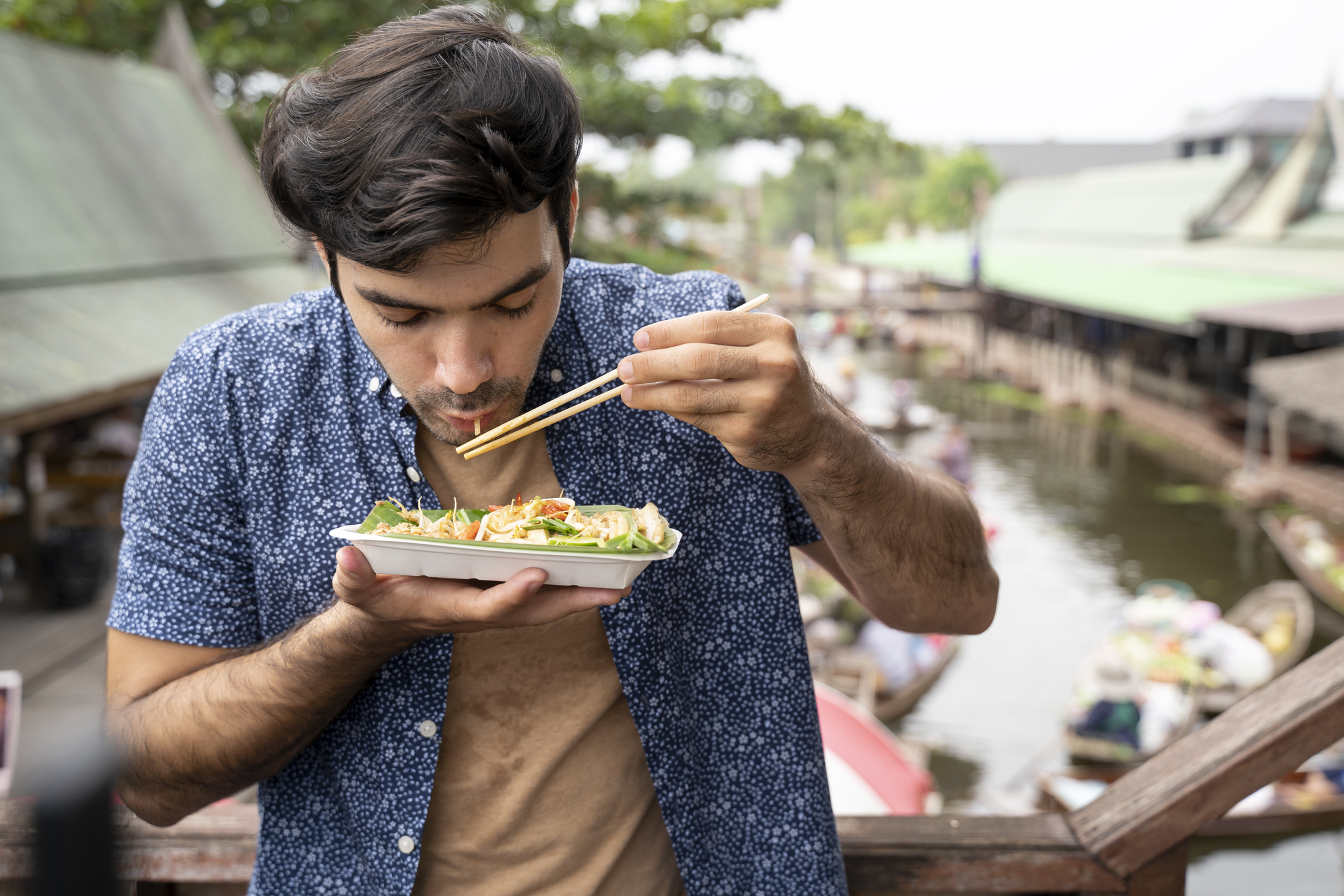Reading time: 5 minutes

What better reason is there to travel than food? These destination-defining street foods make for a more authentic travel experience, so be sure to savour every one of them on your next trip to Southeast Asia – your taste buds will thank you for it.
Halo-halo (Philippines)
This sweet, icy treat serves as a refreshing pick-me-up on your travels when it's hot and humid. Like an ice-cream sundae, only better, Halo-halo combines shaved ice, purple yam, custard, canned fruit, tapioca pearls, evaporated milk and jelly cubes. Different vendors may put their own twist on the standard recipe with rice crispies for crunch or chilli for a spicy surprise.
Phở (Vietnam)
The first mistake most travellers make is to pronounce this soup like 'foe'. It should actually sound more like 'fuh'. A good bowl of Phở has a slow-cooked broth as its base. Noodles and beef, chicken or seafood are added, followed by herbs and other garnishes. Phở recipes vary depending on where in Vietnam you go. In the north, expect a simple soup made with a clear broth; central Vietnam offers a spicier variation; in the south, it's a little sweeter.
Som Tam (Thailand)
This light, fresh salad is popular in central Thailand but can be found throughout the country. Combining strips of zingy green papaya with peanuts, dried shrimp, beans, tomatoes and a salty-sour-sweet dressing, one bite of Som Tam and you'll feel like you've died and gone to heaven.
Char Kway Teow (Singapore, Malaysia)
Originating in China, this stir-fried flat noodle dish might not be the healthiest street food, but it is tasty and satisfying. Expect a bowl of noodles with prawns, Chinese sausage or pork belly (or a combination) in a sweet, salty sauce with egg and beansprouts. Yum!
Roti Prata (Singapore)
In Hindi, roti means 'bread' and prata (or paratha) means 'flat'. Stalls selling Roti Prata are open all day and into the night and you can watch prata vendors stretching and twisting the dough until it quadruples in size. Thin portions of the dough are then folded into a rectangle and cooked on a hot griddle. The texture ranges from soft and fluffy to crisp and flaky, and they can be served plain or filled with everything from egg to ice-cream. Designed to be eaten with your hands, nothing beats using one as a scoop to scarf down an incredible curry.
Amok Trey (Cambodia)
Speaking of curry, no trip to Cambodia is complete without an Amok Trey experience. More sweet than spicy, this fish curry is often cooked in palm or banana leaves and served with rice. The lively dish has a coconut base with turmeric, kaffir lime and galangal giving it its distinctive flavour. Although traditionally eaten during the three-day Water Festival in November, it can be found all year throughout Cambodia.
Nasi Goreng – (Malaysia and Indonesia)
If you've been to Bali, you've no doubt enjoyed your fair share of Nasi Goreng, an inexpensive and widely available fried rice dish as popular with locals as it is with tourists. If you haven't yet had the pleasure, it's definitely time. Nasi Goreng can be spicy or mild, and in seafood, meat and vegetable variations. Shrimp paste, tamarind, sweet soy and garlic give it a flavour punch, while a fried egg on top serves as the finishing touch.
Adobo (Philippines)
Adobo refers to a Filipino marinade that makes slow-cooked chicken, pork and seafood positively mouthwatering. The word Adobo derives from the Spanish word adobar, meaning marinade, which makes sense given the dish came about during the Spanish Colonial era in the Philippines (1521-1898). The marinade is made up of bay leaves, soy sauce, garlic, vinegar and peppercorns (the vinegar and salt handy for preserving food before fridges were invented).
Gỏi Cuốn (Vietnam)
You may well be familiar with these rice paper rolls in your own neck of the woods. Filled with rice vermicelli, salad and tofu, seafood, chicken or pork, these make for great on-the-go snacks when you're travelling. Unlike its deep fried cousin Chả Giò (also amazing), Gỏi Cuốn are served cold and fresh with a thick peanut dipping sauce.
Mohinga (Myanmar)
This Burmese soup is traditionally eaten for breakfast, but street vendors now sell it all day long. The rice noodle fish soup has an intense flavour thanks to lemongrass, chilli and shrimp paste, along with plenty of fish sauce, lime and coriander. Thickened with toasted ground rice, this comforting soup will set you up for a day of adventure. Don't be surprised if it becomes your go-to breakfast during your stay.
Travel Insurance
Sampling in delicious street foods can sometimes be a roll of the dice, often resulting in "traveller's diarrhoea". Travel Insurance Direct can cover you for various things you may encounter on your trip to South East Asia. But what does that mean? Have a look at exactly what we cover and what we don't to check if the policy offers protection for the things you feel are important, but some specific things we offer cover for are:
This is a brief summary of cover only and does not include the full terms, conditions, limitations and exclusions. Read the PDS before purchasing.